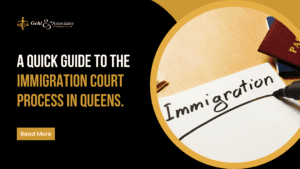
Immigration proceedings are one of the most consequential legal journeys anyone can face in the United States. Hence, understanding how the immigration court in Queens works is extremely helpful. You are summoned into a complex system when you receive a Notice to Appear (NTA). The process can be emotionally and legally taxing.
Most people facing removal proceedings have no idea what’s coming. Unlike criminal courts, immigration courts do not provide you with an attorney. This leaves many individuals to face a federal immigration judge and a Department of Homeland Security (DHS) attorney alone. A Queens Immigration Attorney helps walk you through what to do, what to expect, and how to stay in control. Starting from the moment you receive that NTA to the final judgment on your case
The immigration court system doesn’t move at your pace. It moves according to federal schedules, legal rules, and administrative limits. You risk falling behind if you’re not informed and ready from Day One. The court isn’t interested in whether you misunderstood a form or missed a date. It’s interested in order, evidence, and law.
Key Statistics:
- Master Calendar Hearings are scheduled at least 10 days after a Notice to Appear is served.
- A respondent must submit immigration forms and supporting documents at least 30 days before their individual hearing.
- Master Calendar Hearings were historically scheduled within 2 to 3 months, but can now take up to 3 years.
- Most individual hearings in Queens last between 1 and 8 hours, depending on the complexity of the case.
- In asylum cases, work authorization eligibility begins 180 days after the application is filed, minus applicant-caused delays.
- A respondent has 5 days to submit a change of address form (EOIR-33/IC) after moving.
- A respondent may face multiple Master Hearings before their case proceeds to the individual hearing.
What to Expect When You Arrive at the Immigration Court in Queens?
For many immigrants, arriving at the immigration court in Queens is more stressful than the hearing itself. Even minor confusion about what floor to go to or who to speak with can cause unnecessary panic. The courthouse is located at 26 Federal Plaza, a high-security federal building, which only adds to the anxiety. But knowing exactly what to expect reduces stress and protects your case from preventable mishaps.
An experienced immigration attorney won’t just represent you, they will help you prepare for courtroom logistics. They know where to go, what documents to carry, and what local judges expect. When your nerves kick in, having someone knowledgeable by your side changes everything.
Arrive Early and Prepare for Security
You must arrive early. Security checks are strict. You will need to pass through metal detectors, similar to airport screenings. Expect delays at the entrance, especially during peak hours. Arrive at least 45 minutes early to avoid being late due to unexpected security lines or elevator delays.
Security procedures include:
- Removing belts, shoes, and electronics
- Showing a valid photo ID
- Emptying pockets
- Walking through a scanner and possibly secondary screening
The earlier you arrive, the more time you have to orient yourself. Delays are common, especially if you’re unfamiliar with the building. Your hearing will not be delayed to accommodate late arrival due to long security lines. If you are late and unrepresented, the immigration court in Queens may issue a removal order in absentia.
Check in with Court Staff
Once you pass security, your first task is to check in. The immigration court in Queens might not call your case if you don’t check in. Look for signage that directs you to the proper courtroom or clerk’s window.
Here’s what to expect:
- Check your hearing notice for the specific floor and courtroom number
- Speak to the clerk outside the courtroom or write your name on the check-in sheet
- Let the clerk know if you have an attorney or need an interpreter
- Keep your A-number (alien number) handy to confirm your identity
Missing this step can derail your entire day. Even if you’re physically in the building, failure to check in on time can make it look like a no-show.
Bring These Documents with You
Proceedings at the Immigration court in Queens are document-driven. You must bring everything you need in a neatly organized folder. Judges expect you to have copies of your filings, identification, and any notices you’ve received. Forgetting a critical form or failing to bring requested documents can delay your case or frustrate the court.
Bring the following:
- Your original Notice to Appear (NTA)
- Government-issued photo ID
- Any correspondence from the court or DHS
- Proof of filings (like Form I-589, if applying for asylum)
- Interpreter request confirmation, if applicable
- Biometrics receipts, if requested
- Evidence or supporting documents for your case
- Documents showing you’ve complied with prior instructions (such as EOIR-33/IC address changes)
Your file tells your story. An incomplete file tells the wrong one.
Know What to Do if You’re Late or Lost
Life happens. Trains are delayed, elevators malfunction, or you get lost in the building. But if you’re late, the court doesn’t forgive easily. This is why planning and backup measures are vital.
Here’s what to do:
- Call your attorney immediately if delayed
- Contact the EOIR hotline for guidance
- Ask a building staff member for help if lost inside the building
- Don’t assume the judge will wait or understand delays
Even with a valid reason, a late arrival puts your case at risk. In some situations, your attorney can request a short recess or motion to reopen, but nothing is guaranteed. The better option is to prepare in advance. A Queens immigration attorney can arrive early on your behalf and manage communication with the court if issues arise. Requesting appropriate accommodations when necessary.
What Happens Between Receiving a Notice to Appear and the First Master Calendar Hearing?
The moment you receive a Notice to Appear (Form I-862), your legal reality changes. There is a window between receiving that notice and stepping into your first Master Calendar Hearing at the immigration court.
What are the Contents of Your NTA?
The NTA is not a casual summons. It is a formal legal charge. It’s often the government’s first step toward seeking your removal from the United States. It outlines factual allegations against you. Citing specific section(s) of the Immigration and Nationality Act you are alleged to have violated. Every detail matters.
Carefully read the entire document. The DHS will identify whether you:
- Crossed the U.S.-Mexico border without inspection
- Overstayed your visa
- Had a USCIS application denied
- Entered without a visa
- Were referred to court from an asylum office
Verify these critical parts:
- Your name, date of birth, and A-number
- Entry date and location
- Visa type, if any
- Alleged legal violations
- Box selection indicating your legal status (“arriving alien,” “not admitted,” or “admitted but removable”)
Mistakes here are more than typos. If the wrong box is checked, you could be disqualified from applying for certain types of relief.
Update Your Address with EOIR Immediately
One of the most common and avoidable mistakes is failing to update their address. The immigration court will send all future notices to the address on file. That means you could be deported without getting to plead your case.
You must:
- Submit EOIR-33/IC within 5 days of your move
- Notify both the immigration court in Queens and DHS (OPLA)
- Keep a copy of the form and mailing receipt
Seek Legal Counsel Without Delay
Immigration court is not user-friendly. It doesn’t provide you with an attorney. The judge and DHS counsel are present, but if you don’t have legal representation, you are expected to defend yourself.
You can:
- Appear pro se (represent yourself)
- Request additional time to find an attorney
- Apply for a pro bono legal services list
- Hire an immigration attorney
Know Your Rights and Timeline
Too many people delay because they think they have plenty of time. But immigration relief often comes with strict deadlines. For instance, asylum applications (Form I-589) must be filed within 1 year of your last entry. Even if your hearing isn’t scheduled for years.
Avoid Misinformation
Many people rely on social media, friends, or community advice to handle their immigration process. While intentions are good, bad advice is dangerous, especially when your future is on the line.
Don’t let bad info shape big decisions. Get the facts here.
How Does the Master Calendar Hearing Go in Queens?
At your first hearing at the immigration court in Queens, you won’t be arguing your entire case just yet. This hearing is called a Master Calendar Hearing. This hearing serves as the administrative foundation of your removal proceedings. The judge sets expectations, confirms basic case details, and outlines what happens next.
You Will Enter Pleadings
This is the heart of the hearing. The judge asks you or your attorney to respond to each allegation in the NTA.
Forms of Relief Are Declared
Once pleadings are entered, the judge asks what relief you’re seeking. If you intend to apply for asylum, cancellation of removal, or other legal protections. This is when you declare your intentions. This declaration is not the application itself, but it locks in future deadlines.
Individual Hearing Date Is Scheduled
After pleadings and relief declarations, the judge sets a date for your individual merits hearing.
At this point, the judge may also:
- Set deadlines for evidence submissions
- Ask for biometrics updates
- Confirm if you’ve completed background checks
- Schedule any needed pre-merit conferences
FAQs
Can I go to immigration court without an attorney?
Yes, but it’s not advisable. You can ask for more time to find an attorney if unrepresented at your first hearing.
How do I contact the immigration court in New York?
Call the EOIR Hotline or visit justice.gov/eoir. The hotline provides automated case updates and court information 24/7. You’ll need your A-number to check your status or hearing date.
What cases go to immigration court?
Any foreign national charged with violating immigration laws may be placed in removal proceedings. The court hears cases involving both detained and non-detained individuals.
What happens when you go to immigration court?
You appear before a judge, respond to allegations, and may apply for relief from removal. The judge will assess your eligibility for relief and set deadlines for submitting evidence and forms.
How long does an immigration court case take?
Anywhere from months to several years. Current backlogs can delay Master Calendar Hearings for up to 3 years.
Can I win in immigration court?
Yes. Many immigrants successfully secure asylum, cancellation of removal, or other relief, especially with legal counsel.
Don’t Face the Immigration Court in Queens Alone
The immigration court in Queens is not just a place where hearings happen. It’s where lives are redirected, where futures are either protected or denied. At this stage, preparation is everything. The court doesn’t explain itself. The law won’t wait for you to catch up. Queens immigration attorney argues when you can’t find the words, and fights for outcomes that seem out of reach. Ready to take that first step? Book a free consultation now!




